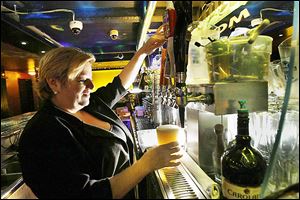
GAP BETWEEN HIGH, LOW END NARROWING
Prices for cheap beer hop up to more stout levels this year
6/27/2013
Daisy Rivas pours a Pabst Blue Ribbon beer at the Gold Room in Los Angeles. A glass of this quintessential cheap beer costs $4. The price of low and mid-range beers is climbing at U.S. bars.
Thirsty beach-goers and barbecuers will be paying more for their cheap beer this summer.
Two recent studies found that prices for low-cost beers have been steadily climbing at bars and restaurants across the United States. Prices for popular brands such as Natural Ice, Miller High Life, and Busch have jumped 6.8 percent in the last seven months — and analysts say they could keep climbing.
The biggest jump in America’s cheap beer offerings: hipster favorite Pabst Blue Ribbon. The beer, affectionately known as PBR, vaulted 11.5 percent in price, according to Massachusetts research firm Restaurant Sciences.
“It’s capitalism,” said Eric Shepard, executive editor of Beer Marketer’s Insights. “It’s a hot product. You can sell it for a bit more.”
Drinkers can now expect to pay $2.67 on average for a PBR, up from $2.40 a year ago, according to Restaurant Sciences. The firm’s survey of 2,500 bars, restaurants, and nightclubs found that other beers in the same category didn’t go up as high at watering holes.
Cheap beer has shown the biggest price increase, but other categories also have gone up, according to Restaurant Sciences. Prices for premium brews have risen 3.6 percent in the last seven months, while super-premium is up 1 percent and ultra-premium added 1.8 percent, according to Restaurant Sciences.
One of the reasons behind the surge in cheap beer has little to do with popularity.
Many of the nation’s big brewers control both high-end and low-end brands. During the recession, beer companies wanted to keep customers drinking higher-priced beers. So they raised the prices of cheaper beers to keep drinkers from switching.
For instance, analysts said that the price gap between Anheuser-Busch’s premium and sub-premium beers had grown for years. The company raised the price of its lower-end Natural Light brand nearly 30 percent since 2011, while its more-popular Budweiser rose just 12.3 percent during the same time period, according to Consumer Edge Research.
“We have worked to narrow that gap, moderately increasing … prices to wholesalers for select brands and markets,” said David Almeida, vice president of sales for Anheuser-Busch.
The price increases have been felt at establishments like the Gold Room in Los Angeles.
Liliana Nava, the manager at the bar, said prices have been going up across the board. Many times the bar had to absorb the cost to keep its customers.
“Everything went up at exactly the same time, you name it,” Ms. Nava said. “But life goes on and we have to cut corners so that we don’t transfer the costs to customers.”
And there’s some indication that the price increases might be driving customers away from cheaper brews to specialty micro-brews. Sales of cheap beer declined 7 percent in the first quarter of 2013 from last year’s first quarter, a continuing trend in the last two years, according to Consumer Edge.
Market analysts have seen customers trading up to high-end craft beer. Purchases increased from 13.7 percent in 2011 to 15 percent in 2012 to 15.6 percent so far in 2013, according to an analysis from GuestMetrics, which tracks the hospitality industry.
“Broadly, consumers are trading up to crafts and above-premium brands,” Mr. Shepard said. “There was a slight increase in sub-premium [sales] at the beginning of the recession, but only for one year.”